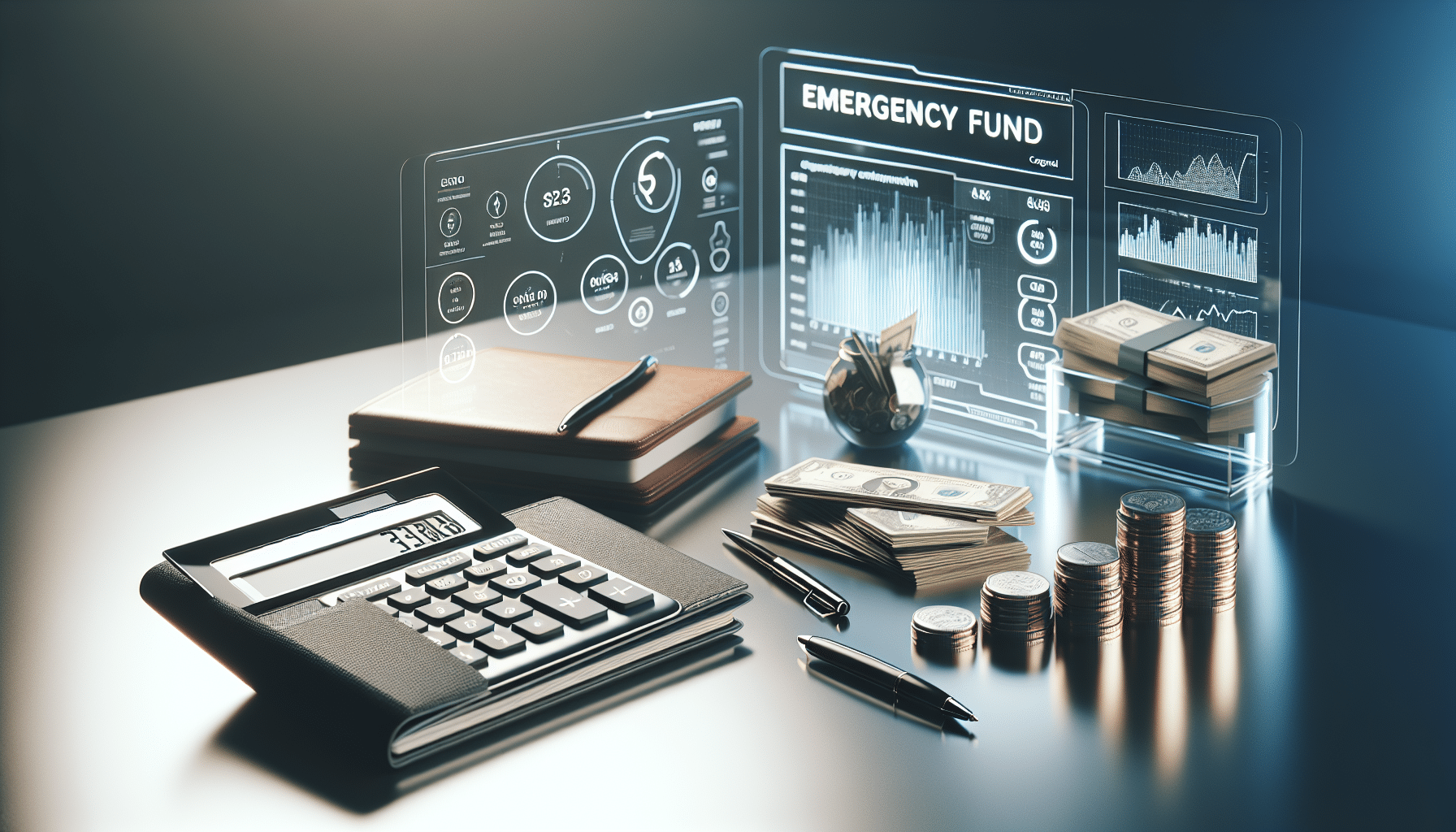Anúncios
If you’ve ever searched for an “emergency fund calculator,” you’re already on the right track to protecting your finances. An emergency fund is your safety cushion, ready to catch you when life throws an unexpected expense your way—think car repairs, medical bills, or a sudden job loss. In this ultimate guide, we’ll walk through how these calculators work, how much you might need to save, and how to keep your money accessible without being tempted to spend it. By the end, you’ll feel confident about building a sturdy financial buffer, even if you’re starting with just a few dollars a week.
Picture this scenario: Your car breaks down right after payday, and you’re staring at a massive repair bill you didn’t see coming. With no emergency savings, you might be forced to rack up credit card debt or skip other important bills. But if you’ve got a little stash set aside, you can handle that repair cost without feeling like your world is caving in. Let’s dig deeper into how to get there, step by step.
Understand why you need a safety net
Life often proves that financial curveballs aren’t a matter of if, but when. It might be a leaky roof or an unexpected medical procedure that doesn’t fit neatly into your monthly bills. According to Bankrate’s 2025 Annual Emergency Savings Report (https://www.bankrate.com), 33% of Americans admit they have more credit card debt than emergency savings. Another 13% say they lack both debt and an emergency cushion, leaving them vulnerable the moment something goes wrong.
Yet building an emergency fund doesn’t have to be complicated. Even setting aside a few dollars each week helps you dodge high-interest debt when an unplanned bill lands in your lap. With a realistic plan, and maybe a quick check using an emergency fund calculator, you’ll have a place to turn before stress takes over.
Not just a rainy day fund
You’ll hear people refer to it as a “rainy day fund.” But an emergency fund is more like a spare tire than a convenience. Tires sit there, ready to roll when you can’t continue driving on your regular wheels. In much the same way, your emergency fund sits quietly, waiting for that crisis you hope never comes. Once you use it, you replace what you spent so you’re prepared for the next bump in the road.
Protect your peace of mind
Having money set aside specifically for emergencies can improve your overall well-being. Around 42% of US adults say money problems affect their mental health. By giving yourself a cushion, you won’t have that dread each time the phone rings with an unexpected bill. The knowledge that you’re prepared for sudden expenses could help you sleep a little easier.
Use an emergency fund calculator
Maybe you’re thinking, “So how do I figure out the right amount to save?” That’s where an emergency fund calculator comes into play. These online tools consider your monthly income, total bills, and living expenses to generate an approximate savings goal. Sure, it’s possible to do the math yourself, but a calculator streamlines the process and can also adjust for personal factors like layered debts or varying incomes.
- It breaks down how much you could aim to save each month.
- It shows how soon you can hit three, six, or even more months of living expenses.
- It factors in your specific cost-of-living details, which might be higher if you’re in a big city or supporting a family.
From a budgeting standpoint, using a calculator is like punching your journey into a GPS. You still have to drive, but now you know which turns to take and how long the ride might be.
Why three to six months of expenses?
Many financial gurus recommend saving enough to cover at least three months of core expenses, especially if you have a stable job and fewer dependents. Others suggest up to six months or more, particularly if you’re self-employed, have a mortgage, or your income fluctuates. An emergency fund calculator can help you land on a figure that fits your specific situation, rather than a one-size-fits-all guess.
One size rarely fits all
If you’re a full-time employee who’s confident in your job security, three months of expenses could be plenty. On the other hand, if you freelance or experience seasonal income, you might want that six-month buffer. You may stumble on some calculators that suggest as little as $500 to start, and that’s valid too—saving small amounts can be lifesaving in a pinch, especially if you’re living paycheck to paycheck.
Decide how much you need
There’s no magic number that works for everyone. Some folks lean on the classic advice to multiply monthly expenses by three, four, five, or six. Others peek at past emergencies (like that time the car’s starter died) to see how much they realistically might need. Reflecting on your history of unplanned outlays can paint a clearer picture of what life throws at you.
- Car owners might save for major repairs like a transmission replacement.
- Homeowners often plan for roof leaks or plumbing issues.
- Parents might consider unforeseen child-related costs such as medical visits or school trips.
Factor in income shocks
Research shows that income loss is one of the most common reasons people tap their emergency funds. Planning for spending shocks is helpful, but what if you’re suddenly without a paycheck for weeks or months? A broader approach is to store enough to cover day-to-day bills while you look for a new job or wait for disability payouts. If you’re in a more volatile industry—like freelancing—lean toward saving on the higher side.
Start small if needed
If you’re overwhelmed by the idea of saving multiple months’ worth of expenses, take a step back. Start with $500 as a micro-goal. This chunk can pay for that urgent vet visit or a minor car repair without leaving you in debt. Then push that amount to $1,000. Once you see the benefits of that initial cushion, it’s easier to build bigger savings targets.
Start building your fund
It’s understandable if you’re wondering exactly how to funnel money into your emergency fund. Begin by tackling the basics of budgeting, then find ways to trim spending or add income sources. If you need a more detailed roadmap on saving tactics, you can explore emergency fund budgeting strategies for practical tips.
- Look at your monthly budget. Where can you trim expenses? Could you cut back on takeout or streaming services?
- Deposit that extra cash into a dedicated savings account, not your regular checking. This helps curb impulse spending.
- Commit to a specific weekly or monthly transfer amount. Even $10 each week is more than $500 in a year if left untouched.
Make smart trade-offs
Some people use “one-time opportunities” to fund their first thousand. This might be a bonus at work, a tax refund, or proceeds from selling unwanted items. Instead of splurging, aim that windfall at your emergency fund. In months with fewer bills, throw in a bit more. The key is consistency: dip into the fund only for true emergencies, and replenish it as soon as you can.
Save automatically
One of the easiest ways to build your stash is to automate the process. If your bank allows it, set up an automatic transfer on payday. The money slides from your checking into savings before you even see it. You’re essentially tricking yourself into saving because you don’t have time to miss those dollars. Over time, these small, steady amounts grow into a formidable cushion.
Choose the right account
Stashing your emergency fund under your mattress might seem handy, but it’s not exactly secure or profitable. You want your funds easily available but also growing, at least a bit, via interest. Two popular choices are:
- High-yield savings accounts
- Money market accounts
Traditional savings accounts are an option too, but the interest rates can be far lower. If you’re looking for more specifics, the importance of emergency savings post covers why accessibility and safety matter so much. Below is a quick snapshot comparing common account types:
| Account type | Accessibility | Interest rate | Best for |
|---|---|---|---|
| Regular savings | Easy (ATM/bank) | Low (0.01–0.10%) | Beginners or partial emergency funds. |
| High-yield savings | Easy (online transfers) | Higher (2.00–5.00%+) | Building emergency savings faster. |
| Money market account | Easy (limited checks) | Moderate (1–2%) | Moderate savings with slight flexibility. |
| No-penalty CD | Medium (withdraw anytime) | Moderate to high | Longer savings with fewer penalties. |
This table is just a starting point. Each bank varies, so shop around for something that checks all the boxes. Remember, you can always split your funds across different accounts if it helps you balance convenience and returns.
Keep fees in check
Some high-yield accounts might require a minimum balance. Others might have monthly fees unless you meet certain conditions. Give the fine print a solid once-over. Even a small fee can eat into your savings progress. Thankfully, many reputable banks and credit unions offer free or low-fee accounts with decent interest rates.
Government-backed insurance
Look for banks that are FDIC-insured, which covers you up to $250,000 per depositor, per insured institution, for each account ownership category. This reassurance means that even if the bank runs into trouble, your money remains protected. If you’re discussing credit unions, look for similar coverage by the National Credit Union Administration (NCUA).
Keep your savings automatic
When you automate deposits, you’re essentially putting your savings plan on autopilot. Some people do this straight through payroll—part of their paycheck goes directly to savings. Others log into their bank app and set up recurring transfers. Either way, you’ll consistently move money into your emergency fund without having to remember or justify each deposit. If you need more beginner-friendly pointers, check out emergency fund for beginners.
Tips for making it work
- Set reminders: If you don’t fully automate, a calendar alert could prompt you to move money manually.
- Pair it with a habit: For example, transfer a small sum every time you get paid or every time you receive a side-hustle payment.
- Celebrate milestones: Hit that first $500, then $1,000, and so on. It’s okay to feel proud as your balance grows.
Think beyond the basics
Automated transfers can also come from multiple sources. If your employer allows direct deposit splitting, send part of your paycheck to your savings account. If you do freelance work on the side, consider a separate auto-transfer program just for that payment. The trick is to reduce opportunities for hesitation or procrastination.
Maintain your momentum
An emergency fund isn’t a “set it and forget it” project. Ideally, you keep reviewing your financial circumstances and adjusting your savings. Maybe you move to a higher cost-of-living area. Perhaps you have a baby. Life changes require rethinking your target total. If your newborn needs specialized care or you end up with bigger housing bills, your fund might need to reflect that.
- Revisit your budget quarterly or annually.
- Bump up your automatic transfers if you receive a raise.
- Replenish the fund quickly after any withdrawal.
Use it when truly needed
It can be tempting to dip into the fund for a vacation sale or a new TV, but let’s be real: that’s not an emergency. Each time you think about spending your cushion, ask, “Is this genuinely essential?” Think big: car repairs, medical costs, or a job-loss bridge are valid reasons. The moment you use it, though, prioritize building it back—just like replacing a spare tire after using it on the highway.
Track your progress
It’s easier to keep going when you see progress. Many people log their total each month or quarter in a spreadsheet. Or maybe you prefer a budgeting app that tracks savings automatically. By visualizing the growth, you can celebrate little milestones. Plus, if you notice your fund is dipping, you can fix that quickly.
Compare account types for your goals
Not all emergencies are created equal. Some might require a quick $500 for new tires, while others might involve being out of work for months. Depending on your goal—whether it’s covering sudden spending shocks or preparing for prolonged income loss—you might want a different vehicle for your money. Here’s a quick comparison beyond our earlier table, focusing on how each account aligns with different saving goals:
| Account/investment | Short-term spending shock | Long-term income shock | Growth potential | Liquidity |
|---|---|---|---|---|
| Regular savings | Great for small shocks | Decent for limited months | Low | Very liquid |
| High-yield savings | Great for both short and medium shocks | Good for limited months | Moderate to high interest | Very liquid |
| Traditional CDs | Not ideal for sudden needs if early withdrawal penalties apply | Better for planned timelines | Usually higher than savings accounts, but not always | Limited until maturity |
| Stocks or mutual funds | Risky if you need immediate cash | Higher growth but volatile | Potentially high (long term) | Not as liquid, potential losses if withdrawn quickly |
| Money market funds | Good for moderate shocks, typically allows limited check writing | Decent if you don’t anticipate multiple withdrawals | Interest can vary | Fairly liquid with some limits |
If you’re focused on an extended period of unemployment, you might be willing to lock up some funds in a low-penalty CD or a more stable investment. On the other hand, if your main concern is a quick car repair or short medical expense, a high-yield savings account might be the best place to park your emergency fund.
Frequently asked questions
“Can I start with just $5 a month?”
Absolutely. There’s no rule saying you must deposit huge chunks right away. The important thing is to build the habit. If $5 a month is realistic, do it, and you’ll see the balance rising gradually. Over time, challenge yourself to nudge that amount higher.
“Should I use retirement funds for emergency savings?”
Generally, it’s better not to. Dipping into 401(k)s, IRAs, or other retirement accounts can incur penalties, taxes, and lost growth potential. That money is meant for your future self, not your next car repair. If you want more ideas on where else to save, emergency fund savings tips might inspire some new approaches.
“Is it okay to keep my entire fund in cash?”
Cash is accessible but doesn’t earn interest. Most experts recommend at least a basic savings account. If your emergency fund calculator shows you need $5,000, you want that sum to earn a little bit, even if it’s a modest interest rate. Otherwise, inflation will nibble away at the purchasing power of plain old cash.
“When do I need more than six months’ savings?”
A six-month buffer is a popular upper limit. However, if your job situation is uncertain—maybe you’re a contract worker or run a small business—it’s wise to aim for nine to 12 months’ worth of expenses. The extra months give you breathing room during longer income disruptions.
Explore real-world scenarios
Let’s say you have monthly expenses of about $3,000. You plug these details into an emergency fund calculator, which suggests three months of savings, or $9,000, as a starting point. That sounds like a lot, but you make a plan:
- You identify $100 of “unnecessary” spending each month (takeout, subscription boxes).
- You set up automatic transfers of $50 from each bi-weekly paycheck.
- You deposit your tax refund and a small work bonus.
In a year, you’ll likely have surpassed $2,000. Keep it up another two or three years, and that $9,000 goal is well within reach. Plus, you’ll have earned interest in a high-yield savings account along the way. If an emergency hits at any point, you won’t have to scramble for a last-minute solution.
Ramp up after hitting initial goals
If you’ve successfully saved that first $500 or $1,000, well done! Now is the time to step it up. You might create a second milestone—maybe $2,000 or one full month of bills. Every time you meet a goal, raise the bar a bit more. It’s okay to tap your fund for a genuine emergency before you hit your overall target. That’s what it’s there for. Just refill it when you can.
Avoid getting complacent
It’s easy to let off the gas once you’ve got a decent cushion, yet emergencies are notoriously unpredictable. Keep your account healthy, and be mindful of any big lifestyle changes that might affect how much you need. Did you adopt a pet that might need vet visits? Did you relocate to an apartment with higher rent? Adjust accordingly.
Consider multiple savings buckets
Once your emergency fund is comfortably established, you could maintain a separate “opportunity fund” or “fun fund” for discretionary items. This approach protects your emergency account from non-emergency splurges. It can also help you feel less guilty about enjoying things like a short weekend getaway, because it doesn’t eat away at your crisis cushion.
Manage debt while building savings
For many people, a major obstacle in saving is existing debt—credit cards, student loans, personal loans. Is it better to focus on debt or saving first? Both matter. You might put most of your extra cash toward high-interest debt but simultaneously set aside a small amount for emergencies. That way, you’re not forced into more debt if an unplanned bill crops up.
- Split your month-end savings: a portion to debt, a portion to your emergency fund.
- Reassess once you pay off a large debt. Move those freed-up funds into bigger monthly contributions for your cushion.
There’s no single right answer here. Just do what feels balanced. The main point is: keep debt from ballooning, but also have a small fallback if something goes wrong.
Tackle big life changes
An emergency fund is more than a pile of money. It’s peace of mind for the big life changes: job loss, family emergencies, sudden moves. If you’ve got multiple dependents or a variable income, consider storing a bit more. Or if you’re just starting out and you have stable employment, a smaller cushion might do.
Planning for self-employment
Freelancers and contractors often face inconsistent pay. If that’s you, budgeting for a gloomier month can make all the difference. Aim for the upper range—six months or more. When income is higher one quarter, sock away more. Let that help you sail through months when invoices come late or gigs slow down.
Health and family emergencies
Medical bills can blindside anyone, and insurance might not always cover what you expect. If you have a family, consider that multiple members could need emergency care at once. Factoring potential out-of-pocket costs into your target total can protect you from substantial medical debt down the line.
Leverage workplace benefits
Depending on your employer, you may have access to certain benefits that can indirectly boost your savings. For example, some workplaces allow you to split your direct deposit between checking and savings. Others might even offer a short-term “hardship fund” or financial wellness programs. These benefits shouldn’t replace your emergency fund, but they can ease stress when you’re in the process of saving.
- Talk to HR about direct deposit splits.
- See if your employer offers an internal savings incentive.
- Ask about any emergency loan programs or paycheck advances in dire circumstances.
Workplace perks vary widely, so it never hurts to inquire. Anything that simplifies how you build your fund is a win.
Check in with your emergency fund calculator
Even after your emergency fund is established, checking in with an emergency fund calculator every so often can keep your approach fresh. Maybe your monthly expenses have changed, or you want to see how a recent raise could accelerate your savings timeline. Keeping your strategy flexible helps ensure you always have enough of a cushion—no more, no less.
Adjust for inflation
As costs go up, your emergency fund target might need to inch Higher. If rent jumps by a couple hundred dollars or your grocery bill skyrockets, it’s worth revisiting your monthly expense number in the calculator. Many tools factor in inflation or higher projected spending, so updating your inputs once a year is a good practice.
Challenge yourself
Some people set additional challenges, like adding $5 more a month to their automated transfer every time they get a paycheck bump. Others initiate a “round-up” feature on their debit card, so each purchase adds a little to savings. Use your imagination. There’s no single route to success—just be consistent.
Keep moving forward
Building an emergency fund isn’t always easy, but the payoff is huge. You’ll feel a shift in your stress levels once you know you have a fallback plan in place. Anytime you face an unplanned cost, it becomes a question of tapping your own reserves, rather than relying on credit or high-interest loans.
Still hungry for more tips? Take a look at emergency fund savings tips for specific ways to maximize your savings, or review emergency fund budgeting strategies if you need help structuring your finances. And if you’re just beginning, emergency fund for beginners will break it down step by step.
By combining the guidance of an emergency fund calculator with practical savings habits, you can gradually reach three to six months’ worth of living expenses—and then some. Whether you’re putting aside $5, $50, or $500 a month, remember that every dollar saved is a dollar you won’t have to borrow under pressure. Here’s to you and the financial security you’re creating, one deposit at a time.








